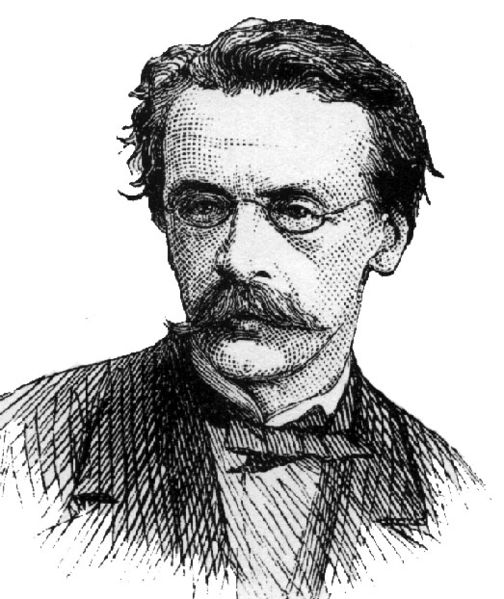 |
| John L. O'Sullivan |
Manifest Destiny had a very religious background, suggesting that God himself had blessed the American
people and the American West, calling the American people to settle this divine land and cleanse the territory of the "heathen" Indians. Many of the Puritan ministers and leaders were instrumental in inspiring westward expansion and were some of the first to cross the Mississippi and fulfill their divine mission. Many writers idealized the Great West with stories of heroic explorers, epic battles with Native American, the beauty of the expansive landscape, and great tales of wild game. Likewise, artists answered the Manifest Destiny call with their art.
 |
| 1848 "Boon's First View of Kentucky" By William Ranney |
The great landscape artists of America painted vast and epic landscapes, portraying the divine nature of the natural landscape. The depictions of nature in these paintings hint at the divinity of nature and the purity of the natural world. These artists also used subtle messages that spoke of environmentalist beliefs and the possible destruction that man may bring to the land. With the divine mission of expansion comes the responsibility to protect it. And though the artists and writers would set free images of the heroic and fantastic West as a playground filled with great opportunity and unfathomable beauty, the reality of the Great West was far from ideal. Travelers would often encounter hostile bandits and Indians, suffer from new diseases, and death was a common occurrence when on out on the trail. While the West was a place of grand beauty, it was also a home to great hardship.
One of the most famous artistic representations of Manifest Destiny comes from artist John Gast in his 1872 piece American Progress. This piece depicts the idea of Manifest
 |
| 1872 "American Progress" By John Gast |
Another painting that speaks of the Manifest Destiny mission is The Oregon Trail, by Albert Bierstadt. "In the year that marked the completion of the first continental railroad, Bierstadt presented a striking allegory of westward expansion. Drawing on his encounter with German immigrants on their way to Oregon, Bierstadt uses the cliffs, trees, and glowing orange-red sky to suggest the spiritual imperative of the move west. The cattle, oxen, and other livestock, along with the covered wagon, create a nostalgic mood. The teepees in the distance are reminders of the Native American presence, but the overall intent of the image is to suggest the centrality of the whites' pioneer experiences to the national character" (Baym C 8).
 |
| 1869 "The Oregon Trail" By Albert Bierstadt |
While the Manifest Destiny writers wove tales of brave pioneers exploring the glorious wilderness, the artists of the time were inspiring Americans with their largescale landscape paintings and depictions of adventuring heroes. Both were instrumental in instilling in the American people a drive for westward expansion.
This was very informative. I never realized how an idea from an essay sparked the events that shaped the west as we know it. In all the history classes I took over the years, I never imagined that the artwork and stories of that time were the largest driving force behind what we know as manifest destiny. I had an idea that religion played into it somewhere also, but always looked at it from a limited perspective. Very compelling.
ReplyDeleteThank you for reading, Phillip! I am glad to have entertained your curiosity. The main driving force of Manifest Destiny was largely religious, advertised by the ministers and clergy, calling that the move westward was a holy mission blessed by God. It was also a venture of economics and of course politics. The expansion West had been going on for a while before O'Sullivan's essay was published, but when he used the term "Manifest Destiny" everything began to pick up swiftly, having now a name to back up the idea.
DeleteThe literature and art of the time played a major role in westward expansion and migration; the epic tales of Western adventures and heroes helped spur people into action, seeking their own adventure. And the art, well, the art depicted the West as a paradise filled with rolling hills, spacious skies, and magnificent trees and wildlife. It was images like Bierstadt's "The Oregon Trail" that really set the mood of the country and inspired people to travel out West. The images created by writers and artists portrayed the West as an American Eden, a paradise and haven of freedom. These images had an enormous impact on the common man. However, as we know now, the West was not always fun-in-the-sun.